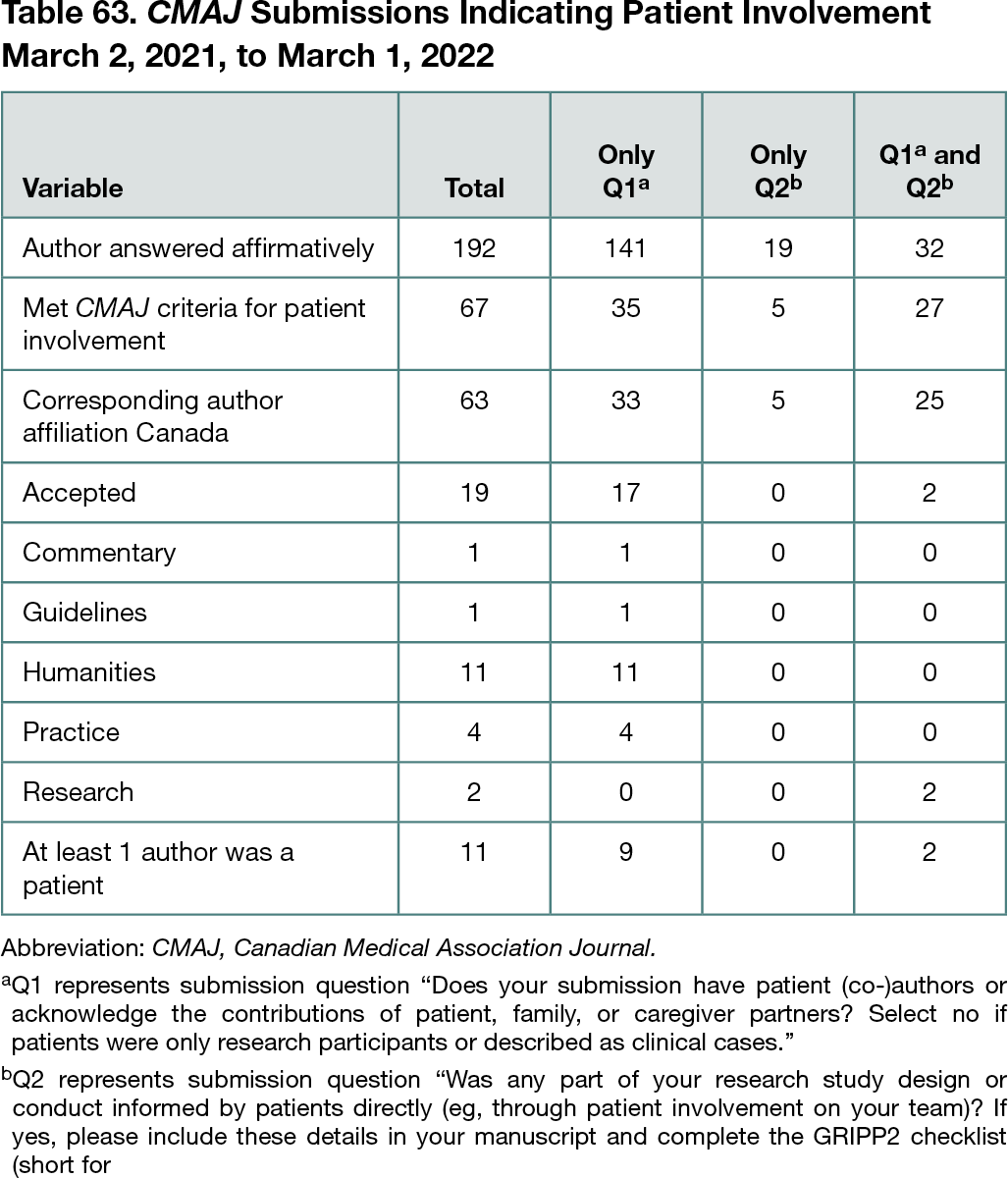Abstract
Using Custom Questions to Assess Patient Involvement in Articles Submitted to a General Medical Journal
Victoria Saigle,1 Meredith Weinhold,1 Kirsten Patrick,1 Andreas Laupacis1,2
Objective
The Canadian Medical Association Journal (CMAJ) has committed to increasing patient engagement in its content (“patient” includes patients, families, and caregivers).1 As part of its evaluation strategy, CMAJ added custom questions to its submission platform to monitor submissions with patient engagement. This study aimed to assess how authors responded to these custom questions and the outcomes of submissions with patient engagement.
Design
This cross-sectional study analyzed CMAJ submissions between March 2, 2021, and March 1, 2022, in which authors responded affirmatively to either of the following questions automatically presented on submission: (1) “Does your submission have patient (co-)authors or acknowledge the contributions of patient, family, or caregiver partners? Select ‘no’ if patients were only research participants or described as clinical cases” (mandatory for all articles) and (2) “Was any part of your research study design or conduct informed by patients directly (eg, through patient involvement on your team)? If yes, please include these details in your manuscript and complete the GRIPP2 checklist (short form)” (asked of research articles only). Submissions were deemed to have patient involvement if a reviewer confirmed that 1 of the authors was a patient or that patient contributions were noted in the cover letter, open text fields, GRIPP2 short-form questionnaire, editor notes, or manuscript files. Submissions to the Research, Guideline, Clinical Review, Commentary, Humanities, Analysis, and Practice sections were included. The final sample was compared with a list of articles with patient involvement published by CMAJ during this time frame.
Results
Among 1879 submissions, 173 of 1879 submitting authors (9.2%) indicated involvement of patient authors or partners, and 19 of 1879 (1.0%) indicated that patients had informed the work but were not authors or partners. Among these 192 submissions, 67 (34.9%) satisfied the journal’s criteria for patient engagement (Table 63). This included 33 of 80 research submissions (41.3%). Sixty-three of 67 submissions (94.0%) deemed to have patient engagement were submitted by authors with Canadian affiliations. Overall, 19 of 63 submissions (30.2%) that responded affirmatively to 1 of these questions and were assessed to have patient engagement were published; among these, 11 of 19 (57.9%) had a patient author. In comparing this list with known publications with patient involvement, an additional 14 articles were identified that did not respond affirmatively to the 2 questions under study.
Conclusions
Most authors incorrectly answered the questions pertaining to patient involvement. Although custom questions may be useful in helping journal staff identify patient engagement in submitted manuscripts, their utility may depend on the submitting authors’ familiarity with terms related to patient engagement. Future work should seek to improve the clarity of these questions.
Reference
1. Saigle V, Miller J, Dumez V, Patrick K. Embedding patient voices in CMAJ. CMAJ. 2021;193(27):E1046–E1047.
1CMAJ, Ottawa Hospital Research Institute, Ottawa, ON, Canada, victoria.saigle@cmaj.ca; 2Dalla Lana School of Public Health and Faculty of Medicine, University of Toronto, Toronto, ON, Canada
Conflict of Interest Disclosures
The authors are all employed by the Canadian Medical Association Journal.

